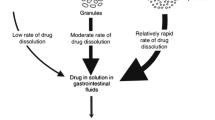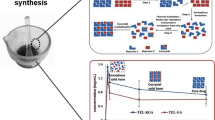ABSTRACT
Alfuzosin hydrochloride is an appropriate candidate drug to prepare a gastro-retention controlled release dosage form since it demonstrates a narrow absorption window in the proximal section of the gastrointestinal tract with a short half-life. The purpose of the present study was to develop and optimize a gastro-floating tablet of alfuzosin hydrochloride by using the compression coating method for controlling drug release in a controlled manner. The floating tablets were developed utilizing hydroxypropyl methylcellulose and carbomer as matrix materials. The impact of formulation factors on buoyancy property and in vitro drug release of the floating tablet was investigated. The “similarity factor” (f2) was used as the indicator for the optimization of the formulations. Furthermore, in vivo pharmacokinetic study in rabbits and correlation of in vitro/in vivo study were also performed. It was found that the optimized formulation F9 could float immediately less than 2 min and remain lastingly buoyant over 24 h and follow zero-order release kinetics well. In comparison with the commercially available prolonged release tablets XATRAL® XL, the prepared floating tablet exhibited similar pharmacokinetic parameters (Cmax, Tmax, t1/2, and AUC0 − t) and plasma concentration versus time profile. Moreover, it indicated from the correlation of in vitro/in vivo study that the floating tablets exhibited a good correlation of in vitro/in vivo. In summary, the compression coating gastro-floating tablets might be a promising drug delivery system for alfuzosin hydrochloride to control drug release.






Similar content being viewed by others
References
Pagariya TP, Patil SB. Development and optimization of multiparticulate drug delivery system of alfuzosin hydrochloride. Colloids Surf B Biointerfaces. 2013;102:171–7. https://doi.org/10.1016/j.colsurfb.2012.08.035.
Fahmy RH. Statistical approach for assessing the influence of calcium silicate and HPMC on the formulation of novel alfuzosin hydrochloride mucoadhesive-floating beads as gastroretentive drug delivery systems. AAPS PharmSciTech. 2012;13(3):990–1004. https://doi.org/10.1208/s12249-012-9823-2.
Elzoghby AO, Vranic BZ, Samy WM, Elgindy NA. Swellable floating tablet based on spray-dried casein nanoparticles: near-infrared spectral characterization and floating matrix evaluation. Int J Pharm. 2015;491(1–2):113–22. https://doi.org/10.1016/j.ijpharm.2015.06.015.
Maggi L, Conte U, Gerenier P, Vergnault G, Dufore A, Jarreau FX, et al. Tablet with controlled release of alfuzosin chlorhydrate. US Patent 6149940A. 2000.
Prajapati VD, Jani GK, Khutliwala TA, Zala BS. Raft forming system—an upcoming approach of gastroretentive drug delivery system. J Control Release. 2013;168(2):151–65.
Lopes CM, Bettencourt C, Rossi A, Buttini F, Barata P. Overview on gastroretentive drug delivery systems for improving drug bioavailability. Int J Pharm. 2016;510(1):144–58.
Pawar VK, Kansal S, Asthana S, Chourasia MK. Industrial perspective of gastroretentive drug delivery systems: physicochemical, biopharmaceutical, technological and regulatory consideration. Expert Opin Drug Deliv. 2012;9(5):551–65. https://doi.org/10.1517/17425247.2012.677431.
Pahwa R, Saini N, Kumar V, Kohli K. Chitosan-based gastroretentive floating drug delivery technology: an updated review. Expert Opin Drug Deliv. 2012;9(5):525–39.
Singh BN, Kim KH. Floating drug delivery systems: an approach to oral controlled drug delivery via gastric retention. J Control Release. 2000;63(3):235.
Raut DS, Rohera BD. Formulation, in vitro evaluation and study of variables on tri-layered gastro-retentive delivery system of diltiazem HCl. Drug Dev Ind Pharm. 2014;40(3):380–9.
Park JB, Hwang CH, Noh HG, Chae YB, Song JW, Kang CY. Zero-order delivery of alfuzosin hydrochloride with hydrophilic polymers. J Pharm Investig. 2010;40(5):285–9.
Huang H, Wu Z, Qi X, Zhang H, Chen Q, Xing J, et al. Compression-coated tablets of glipizide using hydroxypropylcellulose for zero-order release: in vitro and in vivo evaluation. Int J Pharm. 2013;446(1–2):211–8. https://doi.org/10.1016/j.ijpharm.2013.01.039.
Chen K, Wen H, Yang F, Yu Y, Gai X, Wang H, et al. Study of controlled-release floating tablets of dipyridamole using the dry-coated method. Drug Dev Ind Pharm. 2017;44(1):116–24. https://doi.org/10.1080/03639045.2017.1386198.
Li W, Huo M, Chaudhuri AS, Yang C, Cao D, Wu Z, et al. Self-assembled polyelectrolyte complexes films as efficient compression coating layers for controlled-releasing tablets. J Mater Sci Mater Med. 2017;28(5):67.
Jiménez-Castellanos MR, Zia H, Rhodes CT. Design and testing in vitro of a bioadhesive and floating drug delivery system for oral application. Int J Pharm. 1994;105(1):65–70.
Zhu X, Qi X, Wu Z, Zhang Z, Xing J, Li X. Preparation of multiple-unit floating-bioadhesive cooperative minitablets for improving the oral bioavailability of famotidine in rats. Drug Deliv. 2014;21(6):459–66. https://doi.org/10.3109/10717544.2013.879626.
Zhao Q, Gao B, Ma L, Lian J, Deng L, Chen J. Innovative intragastric ascaridole floating tablets: development, optimization, and in vitro-in vivo evaluation. Int J Pharm. 2015;496(2):432–9. https://doi.org/10.1016/j.ijpharm.2015.10.007.
Liu Q, Fassihi R. Zero-order delivery of a highly soluble, low dose drug alfuzosin hydrochloride via gastro-retentive system. Int J Pharm. 2008;348(1–2):27–34. https://doi.org/10.1016/j.ijpharm.2007.07.009.
Efentakis M, Koligliati S, Vlachou M. Design and evaluation of a dry coated drug delivery system with an impermeable cup, swellable top layer and pulsatile release. Int J Pharm. 2006;311(1–2):147–56.
Guinebault P, Broquaire M, Colafranceschi C, Thénot JP. High-performance liquid chromatographic determination of alfuzosin in biological fluids with fluorimetric detection and large-volume injection. J Chromatogr A. 1986;353(3):361–9.
Qi X, Chen H, Rui Y, Yang F, Ma N, Wu Z. Floating tablets for controlled release of ofloxacin via compression coating of hydroxypropyl cellulose combined with effervescent agent. Int J Pharm. 2015;489(1–2):210–7. https://doi.org/10.1016/j.ijpharm.2015.05.007.
Wang L, Yang X, Di Y, Chen K, Wen H, Pan W. Zero-order controlled delivery of gliclazide from polyethylene oxides matrix tables: in vitro and in vivo evaluation. Curr Drug Deliv. 2017;14(1):136–44.
Tiwari SB, Rajabisiahboomi AR. Extended-release oral drug delivery technologies: monolithic matrix systems. Methods Mol Biol. 2008;437:217–43.
Li L, Wang L, Shao Y, Ni R, Zhang T, Mao S. Drug release characteristics from chitosan–alginate matrix tablets based on the theory of self-assembled film. Int J Pharm. 2013;450(1–2):197–207.
He W, Li Y, Zhang R, Wu Z, Yin L. Gastro-floating bilayer tablets for the sustained release of metformin and immediate release of pioglitazone: preparation and in vitro/in vivo evaluation. Int J Pharm. 2014;476(1–2):223–31. https://doi.org/10.1016/j.ijpharm.2014.09.056.
Bertram U, Bodmeier R. In situ gelling, bioadhesive nasal inserts for extended drug delivery: in vitro characterization of a new nasal dosage form. Eur J Pharm Sci. 2006;27(1):62.
Tadros MI. Controlled-release effervescent floating matrix tablets of ciprofloxacin hydrochloride: development, optimization and in vitro-in vivo evaluation in healthy human volunteers. Eur J Pharm Biopharm. 2010;74(2):332–9.
Author information
Authors and Affiliations
Corresponding author
Ethics declarations
Conflict of Interest
The authors report no conflict of interest.
Electronic supplementary material
Fig. S1
Supplemental figure. In vivo evaluation of the gastric retention time of the optimized formulation by near-infrared fluorescence imaging, (A) before the administration, (B) at 1 h, (C) 2 h, (D) 3 h, (E) 4 h, (F) 5 h, (G) 6 h, (H) 7 h after oral administration, respectively (PNG 1452 kb)
Rights and permissions
About this article
Cite this article
Gong, L., Sun, Y., Yu, M. et al. Development and Evaluation of Compression Coating Gastro-Floating Tablet of Alfuzosin Hydrochloride for Zero-Order Controlled Release. AAPS PharmSciTech 19, 3277–3286 (2018). https://doi.org/10.1208/s12249-018-1168-z
Received:
Accepted:
Published:
Issue Date:
DOI: https://doi.org/10.1208/s12249-018-1168-z




